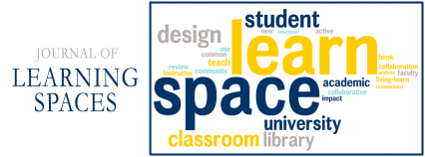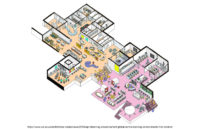Spotlighting Spaces That Anticipate the Future: Stories and Snapshots From the LSC Community
– Alert from January 23, 2021
** Spaces that Anticipate the Future
Introducing an LSC series on spaces that anticipate the future. Through snapshots and stories we illustrate the arc between questions asked in the process of planning spaces for learning and the resulting spaces. Snapshots.
We begin with two stories (from FGM Architects and Perkins&Will) about how students experience spaces, about the profound impact the power of design has on the experience of learning.
** Reflections on the Geography of Place
– An LSC Conversation
From the 2021 LSC Virtual Roundtables, a conversation about topophilia, about the campus as an ecosystem, about how our physical spaces, once thought to be stolid and enduring, need to evolve to help us meet both the moment and the changing needs of higher education post-pandemic.
How have conversations between academics and architects changed as a result of planning in the time of COVID? We will be posing these and other questions to our larger LinkedIn community. Please join us in that conversation.
** From the LSC Roundtable Archives: Planning and Designing for Inclusivity
The LSC, as a community of architects and academics, has a rich archive of resources that capture and advance best practices in planning for assessing learning spaces. It is interesting to note if and how questions relating to diversity and inclusivity differ now—in 2021 from then—in 2016. What has changed?
_____________________________
An LSC Essay: The Agora as a Metaphor for a Virtual Learning Space
– Alert from November 5, 2020
How Can The Historic Sense Of An Agora Be Captured In Virtual Learning Spaces?
This question is explored in this essay from the Learning Spaces Collaboratory. It is the first of a series of working papers crafted by members of the LSC Zoom Roundtable Think Tank.
The Think Tank is a small, diverse group from within the LSC, including representatives of LSC Sponsors and LSC Collaborating Partners. This group has been convening since Spring 2020, exploring questions being asked and those that should be asked as campuses wrestle with how and where learning is experienced in the COVID-19 era.
The question about “agora” as a metaphor for a space for learning has been intriguing us since it surfaced at the initial LSC Zoom Roundtable in May 2020.
We invite your attention and thoughts.
The LSC Roundtables
The LSC Zoom Roundtables
_____________________________
A peer-reviewed, open-access journal published biannually, The Journal of Learning Spaces provides a scholarly, multidisciplinary forum for research articles, case studies, book reviews, and position pieces related to all aspects of learning space design, operation, pedagogy, and assessment in higher education.
We define learning as the process of acquiring knowledge, skill, or understanding as a result of study, experience, or teaching.
Learning spaces are designed to support, facilitate, stimulate, or enhance learning and teaching. Learning spaces encompass formal, informal, and virtual environments:
- formal: lecture halls, laboratories, traditional classrooms
- informal: learning commons, multimedia sandbox, residential study areas, huddle rooms
- virtual: learning management systems, social media websites, online virtual environments
We invite submissions of practical and theoretical works from practitioners and academics across a wide range of subject disciplines and organizational backgrounds, including Architecture, Interior and Product Design, Education, Information and Library Science, Instructional Technology, Sociology, and Student and Residential Life. Submissions should focus primarily on learning spaces and their impact on or relationship to teaching and learning.
Journal of Learning Spaces is an Open Access journal which means that all content is freely available without charge to the user or his/her institution. Users are allowed to read, download, copy, distribute, print, search, or link to the full texts of the articles, or use them for any other lawful purpose, without asking prior permission from the publisher or the author. This is in accordance with the BOAI definition of Open Access.

_____________________________
The editorial in the April 2019 issue of Learning By Design presents three stories from the LSC Community—Clemson University; Texas A&M University; and The University of Calgary—that help define and describe the nature of permeability in the context of learning spaces. (Thanks to SCUP & LBD)

_____________________________
Bartlett Global Centre for Learning Environments
The LSC is delighted to announce our affiliation with the UK’s new Bartlett Global Centre for Learning Environments at UCL, University College London. The Bartlett Faculty of the Built Environment has just been named the No.1 school of Architecture & Built Environment, in the QS 2019 global rankings. The BGCLE draws on knowledge of pedagogy, learning, space and resources, to develop evidence-based guidance to shape great educational environments for the future.
Professor Alexi Marmot, Director of the Bartlett Global Centre for Learning Environments, says: “Linking with Jeanne Narum and LSC allows both groups to share their leading edge knowledge of innovation in shaping environments that help people of all ages to engage, learn and flourish.”

_____________________________
How can an ecosystem approach help in understanding and improving team science? How can this work in practice?
An Ecosystem Approach
Collaborations among scholars from different fields and their community partners are embedded in a multi-layered ecosystem ranging from micro to macro scales, and from local to more remote regions. Ecosystem levels include:
- individual members of teams;
- the teams to which they belong viewed as organizational units;
- the broader institutional contexts (eg., universities, research institutes) that support multi-team systems; and,
- their community and societal milieus (eg., science policies and priorities established by national and international agencies and foundations).
The success of team-based scholarly and translational initiatives depends on circumstances and events at each of these ecosystem levels and the extent to which they are aligned. For instance, the capacity of a science team to create and apply new knowledge is dependent on the task-specific abilities, interpersonal skills, training, and diverse attributes that individuals bring to their teams. Similarly, the viability and productivity of the team is impacted by the support it receives from institutional leaders and research funding agencies.
—Community member post by Dan Stokols, Judith S. Olson, Maritza Salazar and Gary M. Olson
_____________________________
EDUCAUSE is a nonprofit association and the largest community of technology, academic, industry, and campus leaders advancing higher education through the use of IT.
The EDUCAUSEreview: Why IT Matters to Higher Education is an important resource for all. From the current issue:
Higher education is rapidly evolving in response to changing economic models, the emergence and growth of startups, declining enrollments, new student profiles, and an increased emphasis on addressing inequality. For leaders and academics alike, this uncertainty and complexity is disorienting. The scope and the speed of change suggest that higher education cannot continue under an assumption of “business as usual.” Instead, a fundamentally different approach to teaching, learning, administration, and research is required. We believe that complexity science offers the best lens to understanding and managing this change. Through complexity science, higher education leaders can apprehend and make sense of broad-ranging trends, as well as the urgent need to plan for and provide systemic responses.
“Complexity: A Leader’s Framework for Understanding and Managing Change in Higher Education” by George Siemens, Shane Dawson, and Kristen Eshleman.
The Learning Space Rating System (LSRS) project provides a set of measurable criteria to assess how well the design of classrooms support and enable active learning.
ELI Annual Meeting: February 19–21, 2019, Anaheim, California.
Learning Space Taxonomy
The Learning Space Toolkit project developed a taxonomy to aid in the description and organization of learning space and neighborhood profiles. While this is not a totally comprehensive descriptive framework for learning spaces, we have found it to be a useful tool for analyzing existing learning spaces. This taxonomy can be utilized to describe existing and future learning spaces in a more systematic way in order to ensure that the various facets of learning spaces are explicitly considered.
_____________________________
“Everything I Learned About Learning in Kindergarten” by Rebecca Berry, LEED AP, AIA, page 14 in College Planning & Management.
Design standards for kindergarten classrooms – which encourage active and collaborative learning – are making inroads into higher education.
Contrasting pictures come to mind when recalling historically typical learning spaces: from rows of flip-top desks with attached chairs, bolted to the floor, all facing forward toward a blackboard; harkening back to single-room schoolhouses in rural America where younger children would sit up front , older children at the rear of the room, in near total silence, working on their “lessons.”
In the early part of the 20th century, new concepts began to emerge relative to educating young children. Driven particularly by Maria Montessori, the idea of the child as the center of the education process arose.
_____________________________
From the Chronicle of Higher Education:
A Third of Your Freshmen Disappear. How Can You Keep Them?
Colleges redesign the first-year experience to improve retention, learning outcomes, and students’ sense of belonging.
LINK: Access the article here>>>
_____________________________
Making an Old Science Building Relevant Again
UConn Project Updates Structure and Enables Contemporary Teaching Methods
Renovating an old science complex can be a cost-effective way to transform a 1970s relic into an education facility for the 21st century. The Gant Science Complex, built between 1970 and 1974 on the Storrs campus of the University of Connecticut, is big—285,000 sf—but outdated and environmentally inefficient with an R value in the single digits. It also reflects old-fashioned science teaching and research methods, making it hard to enable the kind of collaborative learning used today.
LINK: Access the report here>>>
_____________________________
Reports from the National Research Council (NRC) are essential resources for planners. The NRC report Expanding Underrepresented Minority Participation & America’s Science and Technology Talent at the Crossroads (LINK to report) will be of value in informing discussions about why and how to design for inclusivity.
The Inclusive/Excellence Program at HHMI (Howard Hughes Medical Institute) (LINK to report) signals what is important to address if campuses are committing to increasing in measurable ways their infrastructure, resources, and expertise to involve undergraduate students in science, resulting in expanded access to excellence for all students, and especially those who belong to the “new majority” in American higher education. Best Practices from HHMI grantees can be adapted in other settings.
The June LSC Roundtable Collection II: Essays on Designing for Dissolving Disciplinary Boundaries will spotlight a soon-to-be-released report from the National Academies: Branches from the Same Tree. This report anticipates a future for learning and research in undergraduate environments in which boundaries are dissolved between arts, humanities, STEM fields, and medicine. (AHSTEMM).
Register for the May Webinar introducing this report. (LINK to registration). Free.
